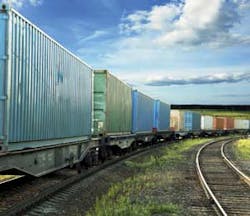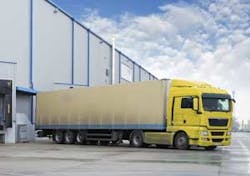Imagine for a moment that it is the future and you are the chief supply chain officer of a consumer products company. You find yourself caught in a nightmarish scenario where you are expected to keep costs down while making same-day -- perhaps even same-hour -- deliveries to consumers at the same time your inbound shipments are ensnarled in unreliable and expensive trucking service.
Okay, you can stop imagining now. That's not really the future; it is the reality today for many logistics leaders.
We can draw this conclusion in part from statements made by some major players in logistics in recent months and from the 2014 State of Logistics Report released June 17 in Washington, DC, by the Council of Supply Chain Management Professionals, and sponsored by Penske Logistics.
At the press conference, the idea that the supply chain is being reforged by increasing demands and shrinking capacity was addressed by a panel of shipper, transport and 3PL provider executives.
The week before in Chicago, similar views and experiences were shared by other logistics executives attending the annual eyefortransport [CQ] 3PL Summit and Chief Supply Chain Officer Forum.
Problems a la Mode
The capacity crunch in rail and trucking is real and is getting worse, but arises from different causes in each mode. For trucking the new hours-of-service regulations are exacerbating an already growing shortage of qualified truck drivers.Trucking: The Biggest Challenge
Trucking is where Jackson and other shippers have seen the biggest negative impact, and one that is getting worse. In an effort to find a solution, he says that his company is turning more to dedicated contract carriage to ensure their trucking needs will be met. And his company isn't the only one.3PL Demand Rising
An improving economy and the burgeoning of e-commerce retailing is exerting pressure not just on carriers, but on the warehouse industry as well. Commercial real estate developers reported record demand for new warehouses and distribution centers starting last year and intensifying this year.
This offers golden opportunities for warehouse-based 3PLs that can provide solutions for customers in consumer products and retail sales segments
FedEx and UPS announced that after the holiday season they will switch to dimensional pricing for ground shipments. This could mean rate increases of 17-30% for larger packages.
"Using 3PLs will be a big part of our strategy and operations in the future at Limited Brands," Jackson notes. Penske Logistics' Althen adds that his company has seen a 40% increase in year-to-year demand for 3PL warehouse management services.
Other warehouse-based 3PLs report that growth of both new and existing business in some cases is exceeding the current supply of available space. "The warehousing services that we use are very tight; there's not a lot of space out there," observes State of Logistics panel member John Herzwig, vice president, distribution and logistics for the Bayer Healthcare Customer Service Center.
The cost of warehousing rose 5.6% in 2013, while industrial property vacancy rates were down almost a full percentage point from the previous year, according to the CSCMP report. "Fourth quarter demand was particularly strong and reached the highest level on record," the report states.
Retail inventories rose 6.2% year-over-year, and increased in every quarter during 2013. Wholesale inventories grew only 2.7%, mostly during the fourth quarter, and manufacturing inventories were up only 2.1% and have remained flat this year in spite of an upward trend in manufacturing
E-Commerce Changes Rules
Some of the highest pressure on the nation's supply chain capabilities is being exerted by the mass migration of shoppers to e-commerce. UPS and FedEx made headlines last holiday season when they failed to meet delivery targets promised by Amazon.com.
Some in logistics say the two-day free shipping model adhered to by Amazon is simply not sustainable.
However unsustainable this kind of free shipping may turn out to be in the long run, it will remain a common practice through this year's holiday season as long as Amazon's e-commerce competitors are under pressure to offer it, too.
A dire prediction for this holiday season was issued by a top industry executive during the Chicago eyefortransport 3PL Summit panel discussion moderated by this article's author. During it Chuck Moyer, CEO of Express Courier International Inc., a well-established ground parcel delivery service serving the South, declared:
"The holiday season in 2012 was an issue. In 2013 it was problematic. In 2014 it is a train wreck coming at us."
As for the cost component, this spring, first FedEx then UPS announced that at the end of the year -- after the holiday shopping season -- they will switch to dimensional pricing for ground shipments, meaning higher rates for larger packages. Although no details were released by either company about the new pricing schedules, logistics executives at the eyefortransport 3PL Summit in Chicago in mid-June estimate that this could mean rate increases of 17-30% for larger packages.
E-commerce retailers are searching for additional delivery options as they embrace same-day and even same-hour deliveries to supply them with a competitive edge in this market.
Amazon's AmazonFresh same-day grocery delivery program began in 2008 in its hometown of Seattle, and last year expanded to Los Angeles and San Francisco. Walmart's Walmart to Go grocery delivery service began in 2011 in San Francisco and San Jose, Calif., and last October started in Denver. Target Store also reported in mid-June that it is testing same-day service in Boston, Miami and the Minnesota Twin Cities areas.
Mastering the Final Mile
Some retail chains like Home Depot are attempting to compete in the e-commerce space by offering customers online ordering and store pick-ups. The store pick-up option is fueling attempts to convert bricks-and-mortar stores to mini-distribution centers, including repurposing abandoned store locations to fulfill that role. Even if only a handful of companies are experimenting with these programs, the growth of e-commerce is fueling a trend not just toward adoption of omni-channel facilities, but also by increasing the number and geographic spread of warehouses and DCs -- a reverse of the previous trend to fewer and larger facilities.
These retailers are taking a close look at a number of delivery options beyond owning their own delivery fleets, including using local parcel delivery companies. It is estimated that 80 percent of deliveries in major metropolitan areas are already made by local trucking companies.
Another potential approach would be following the business model developed by the passenger service Uber, in which individual automobile owners pickup and deliver passengers in a cell-phone based service that is giving fits to traditional services.
Although 3PL professionals shake their heads when they hear this idea -- asking where they will get liability coverage and ensure drivers are qualified -- advocates point out that when it comes to passenger service the driver qualfication and liability issues already have been successfully addressed by Uber.
A company called Cargomatic announced in late June that it is testing an Uber-like delivery service in southern California to connect regional shippers with small fleets and individual truck drivers, and it expects to expand that service to locations on the East Coast before the end of the year. Although Internet-based freight matching services have existed since the late 20th Century, Cargomatic promises a faster service based on smartphone communications and a focus exclusively on local hauling jobs.
Whether or not this turns out to be a viable transportation alternative, one thing is clear: logisticians need to break out of conventional patterns of thinking to deal with this new world. Technological solutions may be the answer, ranging from exploiting marketing analytics and learning how to carve big data into more digestible pieces to improve planning, and literally thinking outside the box when it comes to warehousing and transportation solutions.
Competition is never going away, and being able to answer challenges like the capacity crunch and radically changing customer demands are what will help set your company apart. But that's why you get paid the big bucks, right?
David Sparkman is founding editor of ACWI Advance (www.acwi.org), the newsletter of the American Chain of Warehouses Inc.






